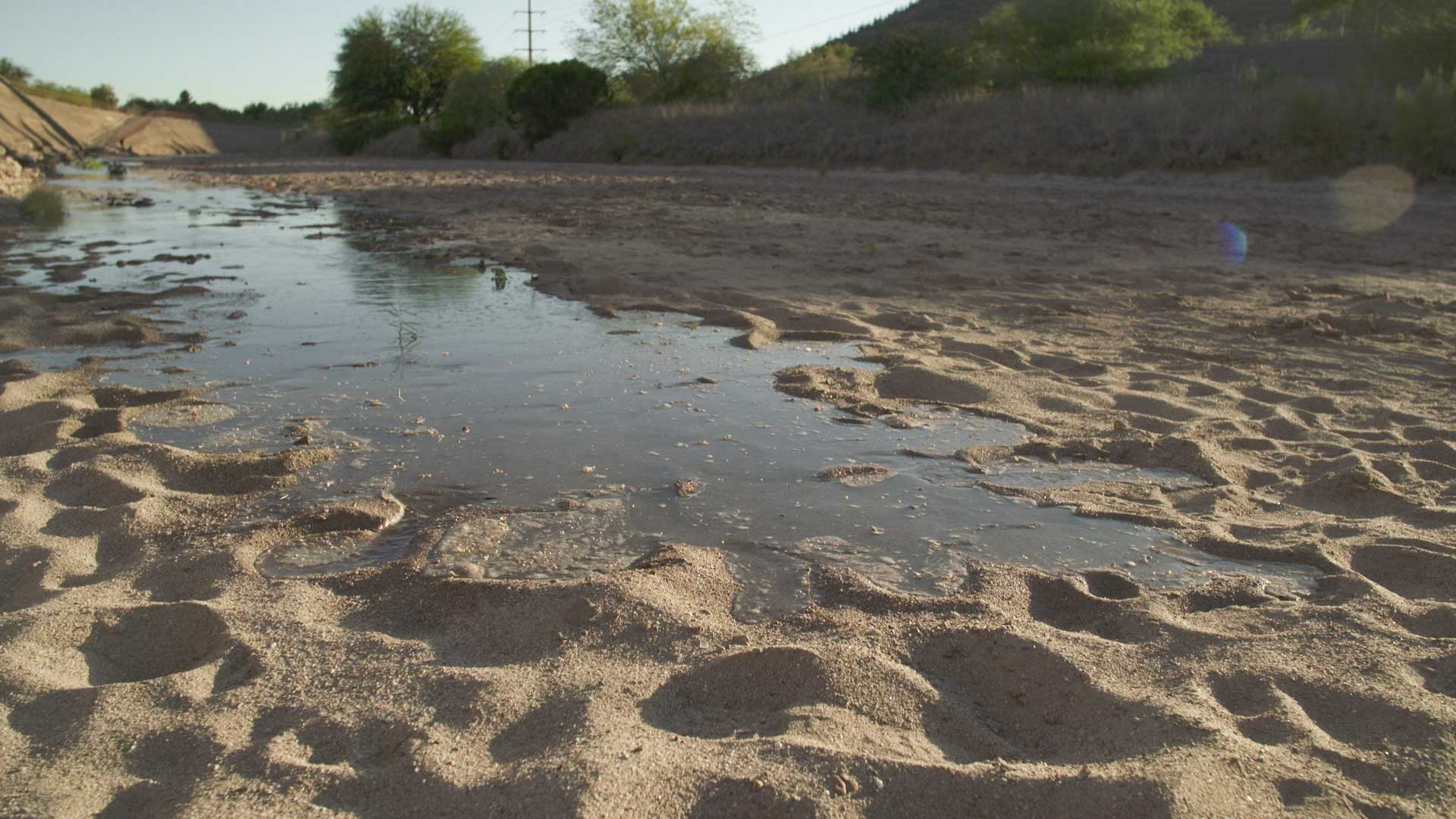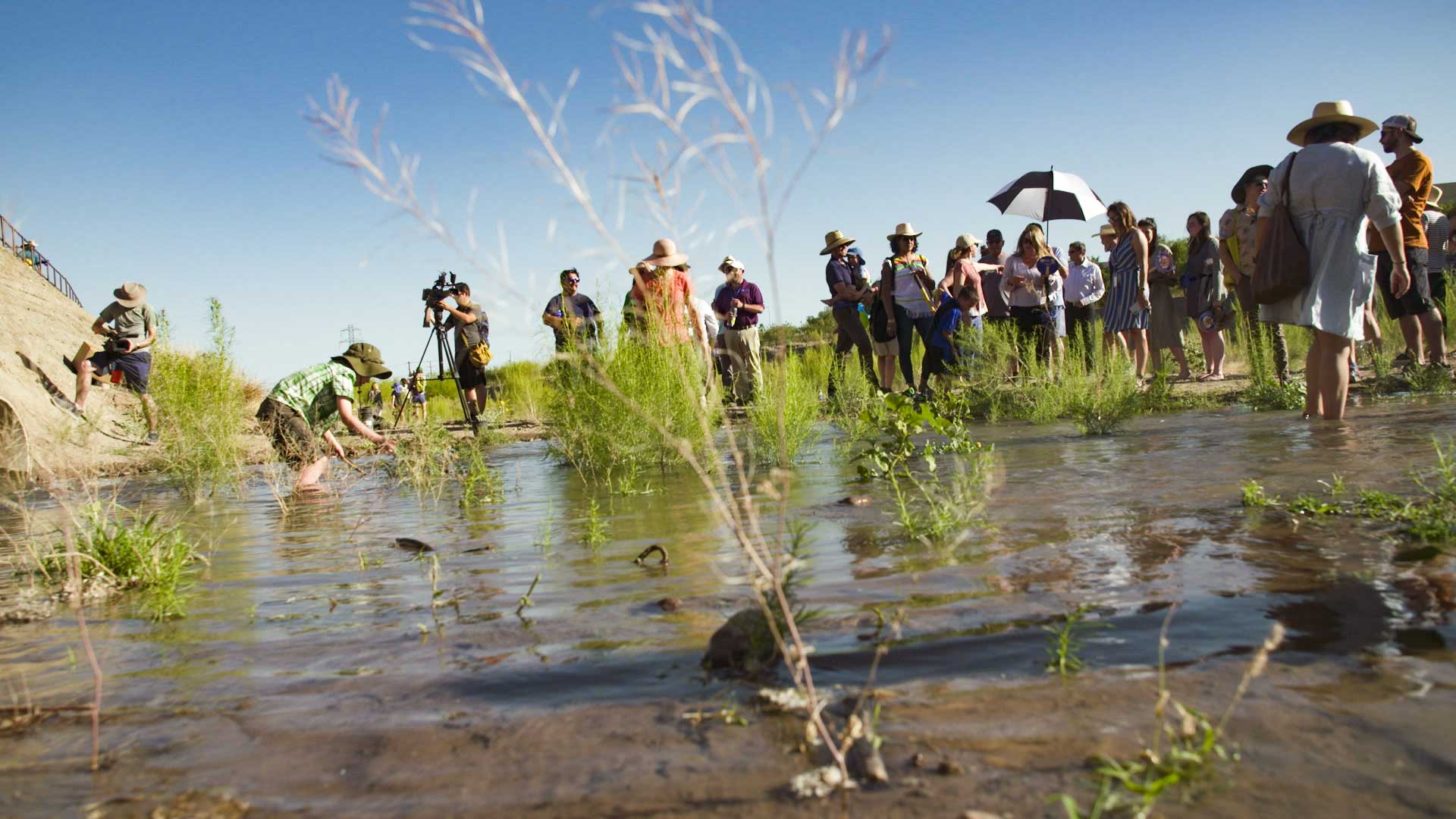 Water creeps along the Santa Cruz riverbed on the release day of a project aiming to create a perennial flow in a section of the river near downtown, June 24, 2019.
Water creeps along the Santa Cruz riverbed on the release day of a project aiming to create a perennial flow in a section of the river near downtown, June 24, 2019.
Making a dried-up section river flow full time can be a heavy lift in the desert, and the city of Tucson hopes a recent project pumping reclaimed water into the Santa Cruz to that end will draw the positive attention of humans and wildlife that live near the banks of the river.
It also draws coordinated efforts. Tucson Water last month opened the valve shortly after the county had finished removing sediment from the same stretch of river in preparation for monsoon flooding. And the flow itself is treated wastewater — industrial effluent and water flushed down the drains of homes and businesses — that has been flowing past neighborhoods and will eventually make its way down to the aquifer.
Santa Cruz flood
One of the goals of the Santa Cruz River Heritage Project is to attract wildlife and encourage native vegetation.
"Once the vegetation starts to build up, it can trap a lot of sediment, and the sediment begins to build up again," said Andy Dinauer, deputy director of Pima County Regional Flood Control District, which carried out the sediment-removal process to accommodate the rush of floods brought by the rainy season.
That project scraped three decades of accumulated sediment out of the river channel, he said, part of the onus inherited from the decision to reinforce the banks years ago with soil cement, setting the river's course.
 VIEW LARGER A truck hauls a load of dirt in the riverbed of the Santa Cruz where it's crossed by St. Mary's, May 16.
VIEW LARGER A truck hauls a load of dirt in the riverbed of the Santa Cruz where it's crossed by St. Mary's, May 16.
"We did have some concerns about what [the city] had as far as a vision for the Santa Cruz, if they were looking for it to be lushly vegetated bank to bank, again it was going to start to compromise the flood-carrying capacity of the channel," Dinauer said.
Tucson Water spokesman Fernando Molina said the project is in its early stages, and that his agency is working closely with flood control.
"We do know that at some point we're going to have to do some cleaning up of the channel to remove these accumulated sediments in the area that we're recharging right now," Molina said.
How exactly they're going to work together to do that isn't clear yet. Dinauer said the city is the primary owner of the watercourse, and the county is responsible for maintenance. But that doesn't mean the project puts them at odds.
"We're pretty supportive of the project. We think we'll be able to find a balance between the river restoration elements and the flood control function of the river. We'll continue to look forward to working with Tucson Water on that," Dinauer said.
He echoed Molina, saying there's time to work it out, but that in the meantime one goal would be to avoid having long-term flows up against the bank, to avoid creating maintenance issues on the sides of the river. That would mean keeping the water as centered in the channel as possible.
"As long as they can keep the vegetation limited — and then if they can keep ... the stream itself kind of centered in the channel — I don't think we're going to have a whole lot of concern about it," Dinauer said.
"At this point it's a really small amount ... less than 5 cubic feet per second, and the channel capacity should ideally be around 60,000 cubic feet per second."
Wastewater treatment
People stood along the river and responded with excitement when the water was released in June, a scene punctuated by river-goers splashing around. That excitement has found city and county officials compelled to remind people not to swim in or drink the treated wastewater.
The city's Molina said the reclaimed water is permitted for incidental contact, meaning splashing around is fine, but swimming in or drinking it are no-nos, especially after it hits the channel.
"Just be aware that it is river water, so there are some health issues that you need to consider there," he said.
Before it is pumped into the riverbed, though, the one-time sewage will have passed through the county's Agua Nueva facility to start the wastewater treatment process, which involves physical and biological measures to remove organic materials and pathogens prepare it to meet the state's "A-plus" criteria.
Jeff Prevatt, the deputy director for Pima County Regional Wastewater Reclamation's treatment division, says that's the highest standard for pathogen and nitrogen reduction.
"We test it, and it's non-detect for fecal coliform and E. coli when it leaves our facility.
"You're not getting any kind of ammonia or nitrogen compounds that are migrating into the groundwater. That groundwater's being purified, and there's far fewer pathogens because the water's disinfected to a higher standard."
But you're not supposed to drink it. He said some of the bacteria can be injured and regrow once they hit the river. On top of that, the river channel will have all sorts of contaminants, including animal waste.
But in terms of partial contact, he said, "it's perfectly safe. Just don't ingest it and use precautions."
 VIEW LARGER People splash around in reclaimed water being pumped into the Santa Cruz River, June 24, 2019.
VIEW LARGER People splash around in reclaimed water being pumped into the Santa Cruz River, June 24, 2019. The wastewater leaving the county facilities technically meets a high standard as it relates to the term "safe," according to Prevatt.
"I wouldn't drink it. Obviously everybody has a certain expectation of what drinkable water looks like. Obviously this is effluent. You would want it treated to a higher standard. But it does meet all the water quality criteria that would qualify for drinking water."
One of the goals of the Santa Cruz River project is to recharge the aquifer through the river channel. Prevatt said they test the water as it migrates down through the soil.
"The further it goes down, the purer and purer and purer that water gets until it's equivalent to groundwater-quality water."
Managers and some riparian habitat enthusiasts are also hoping the water attracts more wildlife. Prevatt said that treated effluent poses no danger to the animals and organisms that are going to use it.
Prevatt said analytical techniques have gotten more sophisticated, leading to more finds of pharmaceutical compounds in wastewater — and more headlines — but at lower concentration levels. So low, he said, as to be negligible.
"Let's say birth control or acetaminophen — those are things that people consume every single day. We see them in such low doses that you would have to drink the equivalent of several swimming pools full of water even to achieve the same dose as a single pill that people take," Prevatt said.
He said his work has a PR aspect to it, in getting people on board with accepting the quality of the water, despite the stigma of its origins. That work is important in the desert.
"We live in a drought-ridden area, and we've gotta make use of every drop."
That mentality is not only important for a city that wants to use wastewater to make its rivers flow and keep its golf courses green, but also for a region he says may need it for drinking water in the future.

By submitting your comments, you hereby give AZPM the right to post your comments and potentially use them in any other form of media operated by this institution.